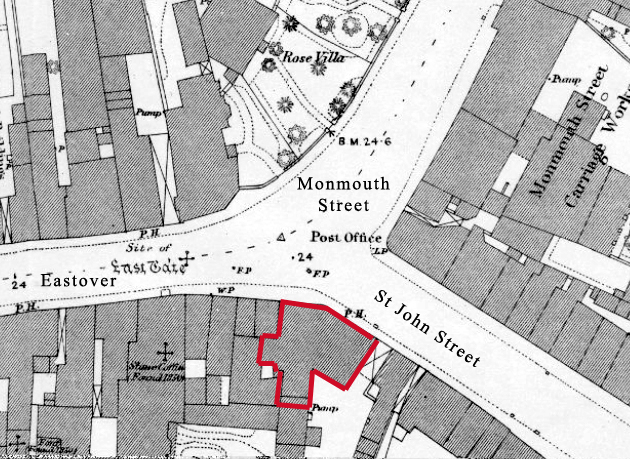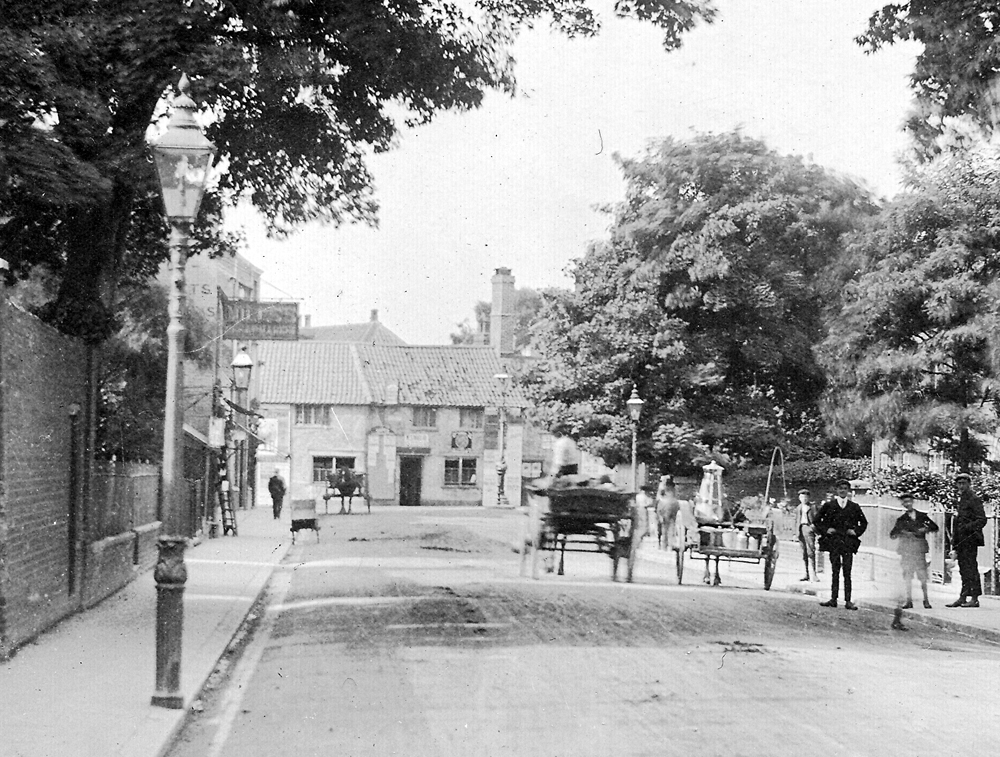The Queen’s Head Inn (c.1700-1908) and Hotel (1908-1957), St John Street

The facade of the Queen’s Head Hotal, as seen above, was built in 1908 to the designs of Samson & Cottam, architects. The work was carried out for the firm of J.Brutton & Sons. The gentleman in the doorway could possibly be Henry James Aplin, who was landlord from 1906 to 1919, or it could be George Buckland, landlord 1926-1941. These buidings were demolished in about 1957, to make way for the Broadway bypass.

The Queen’s Head as an institution is much older though, and was known as the Queen’s Head Inn for most of its existance. The earliest mention seems to come in 1744, with mention of the landlord, John Fletcher, who is last mentioned in about 1780. In 1758 the Town Council were paying for works at the property. The name would refer to the painted sign above the door, most likely of Queen Anne (1702-1707), which might indicate roughly when the Inn was founded. Queen Elizabeth I (1558-1603) would be much less likely, as the site on which the Inn was located was flattened during the Civil Wars of the 1640s, to provide clear fields of fire for the defences around the East Gate. In earlier times the site was part of the Hospital of St John. In 1830 the Queen’s Head Inn was owned by John Barrett of Eastover. In the Western Gazette of 6 January 1871 we find mention of the former Landlord Charles Collins, having stolen moeny from the new Landlord, Henry Whiting.

Taunton Courier and Western Advertiser 6 April 1957
Pottery and Bones at Bridgwater: Discovery on Site of Old Hospital
Traces of the foundations of Bridgwater’s 13th century Hospital of St John, together with human bones and pottery, have been found during excavations at St John’s Lawn for the new relief road. A drainage trench was being dug on Friday when a workman came upon two piles of human bones at a depth of six feet, one containing a skull. Each pile was beside remains of an old wall of red sandstone and blue lias, similar to the materials of which the old castle was constructed at the same time.
The spot is situated at the rear of the former Queen’s Head Hotel, which stood at what will now be the entrance to the new road from the junction of Eastover, Monmouth Street and St John Street. One of the old walls is as much as eight feet in width and the other five feet wide. Both run southwards and no doubt belonged to the medieval hospital.
Founded in 1215 by William Brewer, lord of the castle, in whom King John granted the town’s first charter, the hospital was a monastic establishment, which lasted for 300 years until Henry VIII dissolved the monasteries. It was in charge of a master who was Rector of the town and under whom were 12 brothers. The hospital stood beside the old East Gate at the southern end of Eastover and had a postern door through which travellers could enter after the East Gate had been closed for the night. It covered a large area as it included a church, cloister, chapter house, living quarters for the brothers, guest house, infirmary, gardens, fishpond and a graveyard.
Some ruins remained until the end of the 18th century and, during building operations many years ago, a number of relics were found, including a stone coffin, weapons and human bones. The Borough Coroner was informed of the bones discovered and the potter, which has a green glaze typical of the period, was examined by members of the Blake Museum Advisory Committee. On Monday bones from three other skeletons were unearthed on the site in proximity to St John Street. Old cellars were earlier found under a bungalow recently demolished behind the National Insurance Offices in St John’s Lawn. It was reported to the Town Council on Thursday that while a sewer main was being laid in Friarn Street, five cellars were found under the roadway. As a result the contractors had to double handle materials at an extra cost of 120 pounds. Mr J.G. Headford expressed surprise that the cellars were not discovered before. Alderman W.O. Coate replied: ‘Wherever you dig a hole in Bridgwater you come across cellars, wells and skulls’.
In the following week’s issue a mention is made that no inquest would be held in regard to the bones, and that they would ‘be replaced on the site and no further action taken.’
The architectural drawings can be seen in the Somerset Heritage Centre, A\CMY/192. See also DD/ED/1831/6 and D/B/bw/1970. Landlord infomation taken from David Williams, Bridgwater Inns Past & present (1997)
